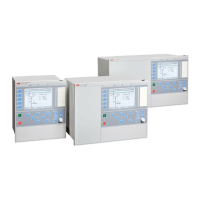selected with the Operation mode and Directional mode settings. Operation mode
defines which operation criterion or criteria are enabled and Directional mode defines
if the forward, reverse or non-directional boundary lines for that particular operation
mode are activated.
Table 359: Operation criteria
Operation mode
Description
Yo Admittance criterion
Bo Susceptance criterion
Go Conductance criterion
Yo, Go Admittance criterion combined with the
conductance criterion
Yo, Bo Admittance criterion combined with the
susceptance criterion
Go, Bo Conductance criterion combined with the
susceptance criterion
Yo, Go, Bo Admittance criterion combined with the
conductance and susceptance criterion
The options for the Directional mode setting are "Non-directional", "Forward" and
"Reverse".
Figure 169, Figure 170 and Figure 171 illustrate the admittance characteristics
supported by EFPADM and the settings relevant to that particular characteristic. The
most typical characteristics are highlighted and explained in details in the chapter
Neutral admittance characteristics. Operation is achieved when the calculated neutral
admittance Yo moves outside the characteristic (the operation area is marked with
gray).
The settings defining the admittance characteristics are given in
primary milliSiemens (mS). The conversion equation for the
admittance from secondary to primary is:
GUID-2F4EAEF7-0D92-477F-8D4C-00C7BEDE04CB V1 EN (Equation 23)
ni
CT
CT ratio for the residual current Io
nu
VT
VT ratio for the residual voltage Uo
Example: Admittance setting in the secondary is 5.00 milliSiemens.
The CT ratio is 100/1 A and the VT ratio is 11547/100 V. The
admittance setting in the primary can be calculated.
1MRS758755 A Section 4
Protection functions
REC615 and RER615 335
Technical Manual

